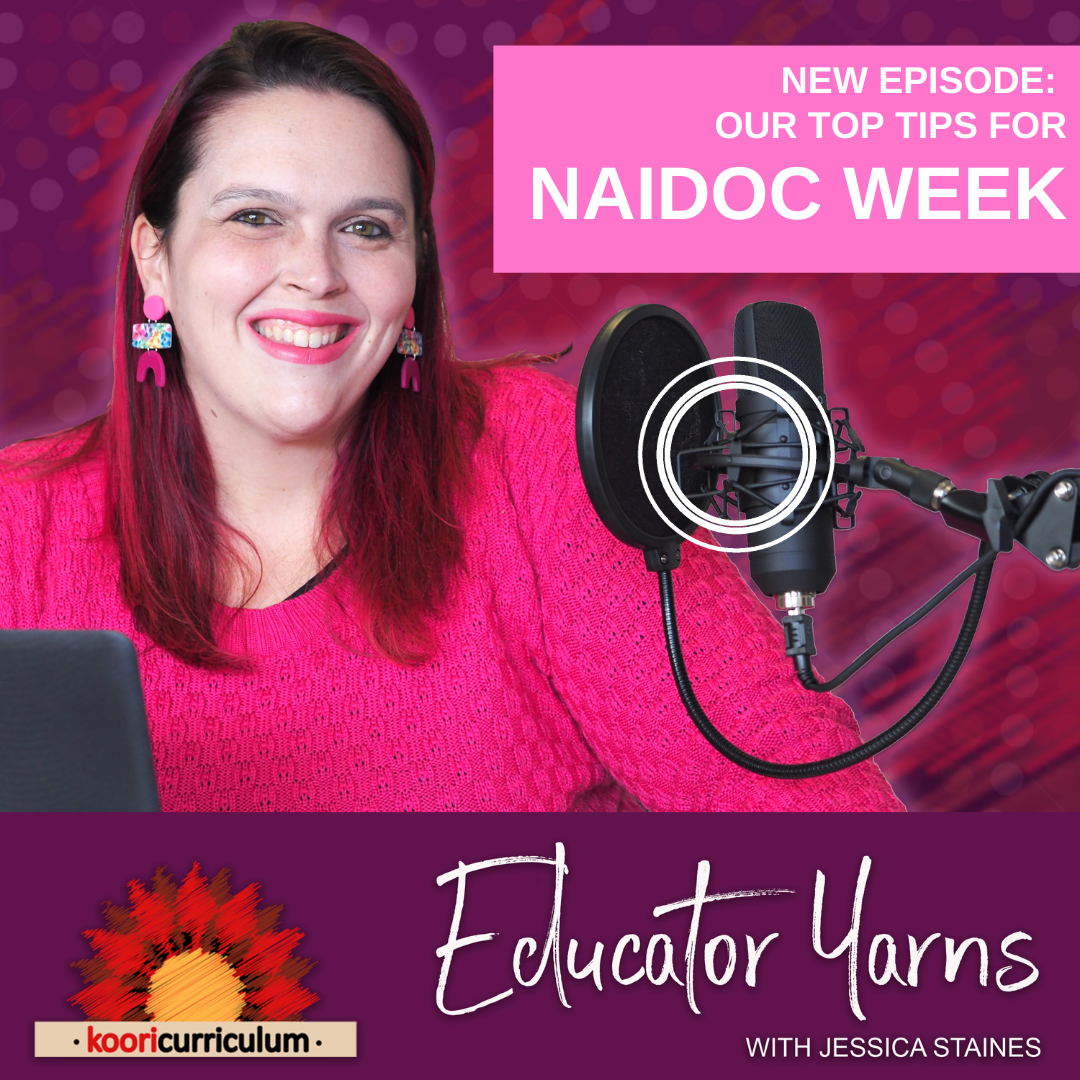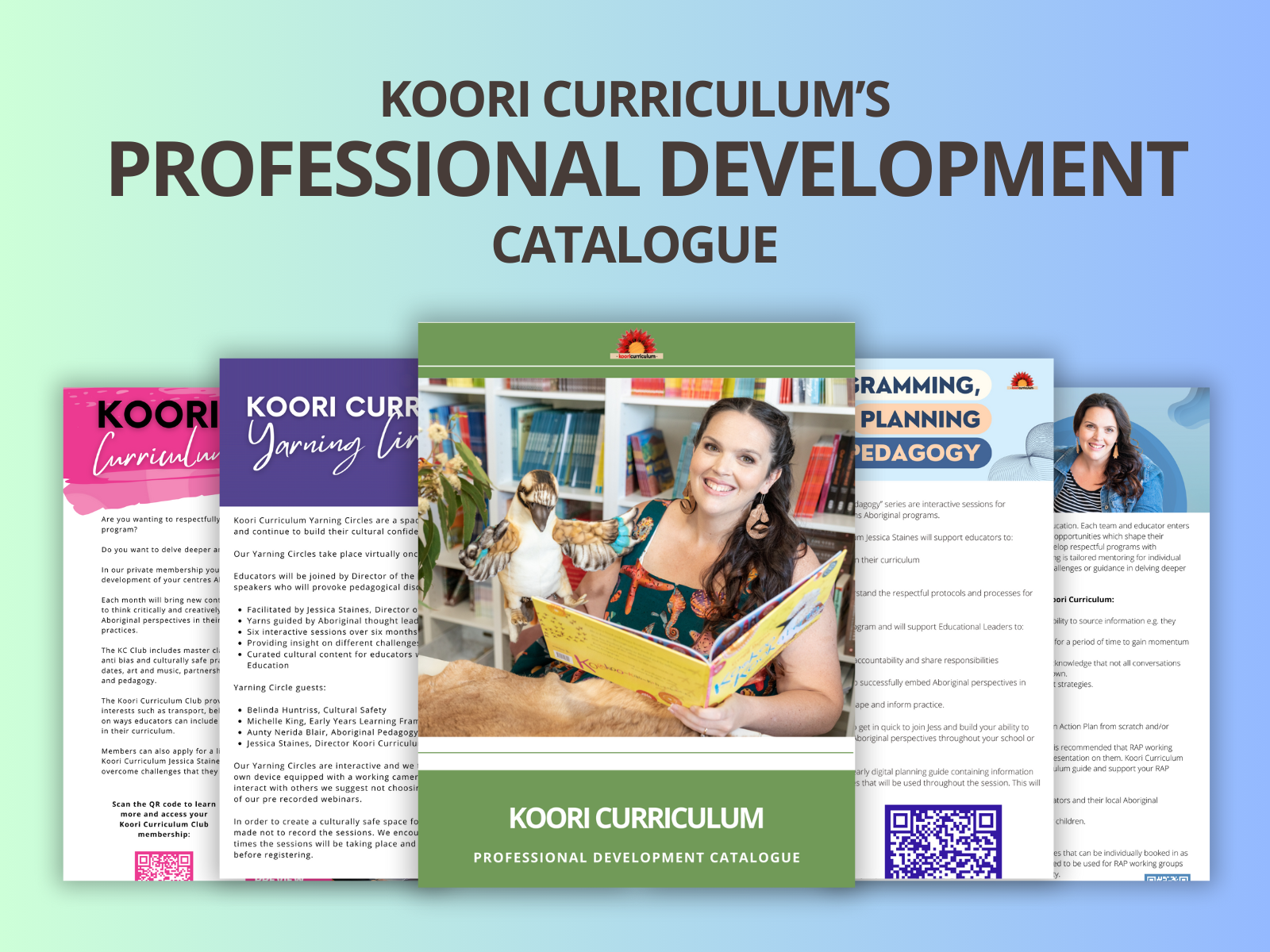
Educator Yarns Episode 14: Our top tips for NAIDOC Week
Hi, everyone. Jess Staines here, director of the Koori Curriculum. During this podcast episode solo, and I will be talking to you about NAIDOC Week. As we start to approach July, our inbox normally gets flooded by educators who enthusiastically starting to plan and programme for their NAIDOC experiences and activities. We thought to make things easier we would put together some of our top tips for NAIDOC Week to get everyone started on the right path. Now, as many of you may know, NAIDOC Week historically is from the first Sunday in July to the second Sunday in July. It's the first full week of July is where NAIDOC usually occurs. However, if you're listening in real time, due to the current pandemic, NAIDOC has been moved to later in the year when hopefully community gatherings will be back taking place.
Nonetheless, there's no reason that you can't be using this time to reflect and review and consider how you are embedding Aboriginal and Torres Strait Islander perspectives in your programme. Including culture is not just something that we do during NAIDOC Week. It really is something that we do throughout the whole entire year, and for many educators who are just setting out and beginning their journey, usually this is that catalyst for them; that tap on the shoulder and starts them on the right pathway. You might as well start putting your best foot forward. For those of you that have been celebrating and acknowledging NAIDOC Week in your programme for many, many years, you may still learn something, so listen in.
My top tip is to research the history of NAIDOC Week. You would be surprised how few people actually know what NAIDOC stands for. When it occurred, how it came to be, so I think the first thing that we need to do as a staffing team is really research what NAIDOC stands for and get some context, because how well can we possibly be including the celebration if we don't know what NAIDOC stands for, and because I really want to empower you to do this researching and investigating yourselves, I am actually not going to tell you. I'm going to advise you to jump on the NAIDOC website, which is www.naidoc.org.au and have a read about the history there.
The next thing you can start doing is you can order the NAIDOC poster. Every year there is a poster competition where Aboriginal and Torres Strait Islander artists right around Australia will make a submission, which is reflective of this year's current theme. The winner then is broadly advertised and marketed online and through the posters that get sent out to every school or university or workplace. You can order the NAIDOC poster, and then once the poster comes to your service, we can be using this poster as a provocation in art experiences, in the art studio, and to do a bit of an artist investigation with the children.
We should also be discussing at a staff meeting the meaning and significance of past and present themes. This year's theme is always was, always will be, which to me really is about our identity as Aboriginal people and as traditional owners, because the chant goes always was, always will be Aboriginal land. As many of you know, Australia was founded on a term called Terra nullius when the English invaded, which meant land belonging to no one, so it's about rebutting those myths and advocating for constitutional recognition, acknowledging that Aboriginal people are the rightful traditional owners of Australia, as we do have the oldest living culture in the world, which has 65,000 years strong. Reading books like Dark Emu by Bruce Pascoe is a way that you can do that as a reflective reading as a team, and there's Young Dark Emu, which is for the classroom. As many of my listeners will know, I'm a huge advocate for ensuring that children have access to a range of both fiction and nonfiction books.
Another key part of NAIDOC week is the NAIDOC Awards. This is where we acknowledge achievements of Aboriginal and Torres Strait Islander people. There are different award categories; elder of the year, or artist of the year, youth of the year, trainee of the year, sports person of the year, just to name a few, and you could be creating a hall of fame in your service that acknowledges past and present winners and learning about who Aboriginal and Torres Strait Islander people are that we are proud of. You can also begin discovering where events are taking place in your local community. Again, when those community events are happening later in the year, you can jump on the NAIDOC website, put your postcode in, and it will tell you what's happening in and around where you are. There are also lots of virtual events that will start taking place from July.
You should be planning to attend local community events as a team and have that cultural immersion experience together, and think about how you can share with families in a newsletter the significance of NAIDOC Week and any events that they might like to attend on the weekend with their children. You could watch the NAIDOC Awards with your team, and you should also be reflecting on how you can embed Aboriginal perspectives in your programme the whole year through. Whilst his might be a starting place, we really don't want this to be it. We really want you to consider how you can be doing and embedding Aboriginal perspectives across the curriculum the whole year through.
Doing things like flying the Aboriginal and Torres Strait Islander flags, which we encourage you to do anyway, investigate the possibility of having an artist or elder in residency programme that extends well beyond NAIDOC Week. I think this is important to remember is I know that a lot of black businesses and cultural performers get inundated with requests to come and deliver their services during NAIDOC Week, but remember that we are Aboriginal the whole year through and we'd love to think about how you can engage and create opportunities for Aboriginal and Torres Strait Islander people in your workplace throughout the entire year.
Then think about how you can discover Aboriginal children's books and ones that particularly lend themselves well to this year's theme is Our Home, Our Heartbeat by Briggs, which talks about famous Aboriginal and Torres Strait Islander people, and it's the rendition to his song, The Children Came Back, which originally was Archie Roach's song. This is a fantastic book and a provocation that I would recommend for early years, primary, secondary, and even for adults. The other one is called Finding the Heart of the Nation, which is by Thomas Mayer, and this is the children's book that goes with Finding our Heart, which was all about the Uluru Statement, so there's a children's version and an adult's version. I recommend both, but the Uluru Statement is something that I really think now more than ever, with the current Black lives Movement that many of you are aware of taking place, it's such a timely reminder of indigenous people's rights within Australia and what we are advocating for in terms of self determination.
I hope you have enjoyed my top tips. If you are wanting more information about how your service can be celebrating and acknowledging NAIDOC Week, we have two webinars which are really appropriate for this. The first one is called Challenging the Culture of Celebrations, which talks about how we can do this inclusively, respectfully and meaningfully in our programme in line with the Code of Ethics, and the other is our NAIDOC Week webinar. Both of these webinars are priced at $20 each, and you can find them on the Koori Curriculum website, www.kooricurriculum.com. Thanks so much for joining me for this short and sweet episode. I hope, again, that you found this information useful. [inaudible 00:09:55] you all again soon. Thanks for now. Bye.



